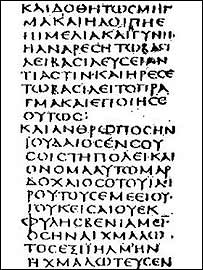|
English Language
|
Before Writing: Signs and Symbols
Signs and symbols are both primitive precursors of written language and important modern supplements to it. They preceded the Western alphabet.
Victor Turner gives us the following definitions:
"in symbols there is always a likeness but in signs there need be no likeness."
In other words a sign is arbitrary - a symbol is not.
The purpose of writing is information storage. It transmits thoughts to a reader even after the passage of time, when memory has faded, even after the writer is dead. In this way economic and cultural notions can be passed on between generations and can have a lasting impact on society.
Simple trading and property signs were used in Mesopotamia before 3000 BC to show ownership especially useful when trading passed ownership from one person to another. The use of a "tally" as a receipt was simple and memorable confirmation of a transaction.
 |
Codex sinaiticus, Ancient Greek
version of The Bible, dated to 4th century. more
... |
The "wampum" belts of the North American Iroquois used complex colours and patterns to represent moods and feelings and were used in ritual ceremonies and as currency.
Egyptian writing is a good example of the way ideographic (pictures of ideas) and phonetic (pictures representing sounds) elements can be used at the same time in the same script.
The development from pictographs (pictures of things) to ideographs (pictures representing ideas) is simply described as follows:
a drawing of
a leg could represent a leg. This is a pictograph.
a drawing of a leg could represent the idea of walking, two legs could
represent "go." This is an ideograph.
Later the drawing could be simplified and used as part of a more complex code system, as in China where individual drawings could be assembled together into a complex ideograph, or even used to represent individual sounds as in our Western alphabet.
|
|